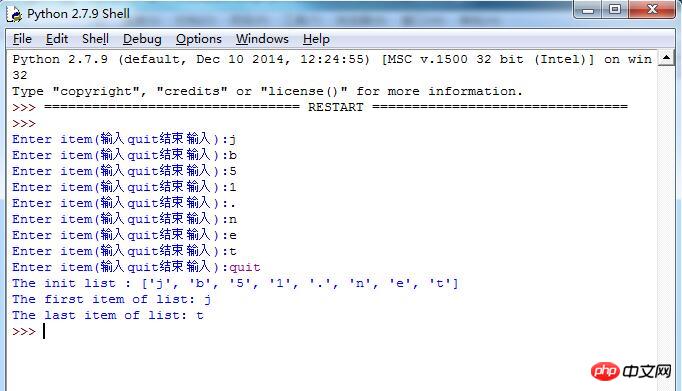
Cet article présente principalement les méthodes d'ajout et de pop basées sur des listes de Python pour implémenter les fonctions de pile et de file d'attente. Il analyse l'utilisation par Python des définitions de liste et les techniques d'exploitation associées à l'utilisation des files d'attente sous forme d'exemples. 🎜>
L'exemple de cet article décrit comment Python implémente les fonctions de pile et de file d'attente en fonction des méthodes append et pop de la liste. Partagez-le avec tout le monde pour votre référence, les détails sont les suivants :#coding=utf8
'''''
堆栈:
堆栈是一个后进先出(LIFO)的数据结构。
在栈上"push"元素是个常用术语,意思是把一个对象添加到堆栈中。
删除一个元素,可以把它"pop"出堆栈。
队列:
队列是一种先进先出(FIFO)的数据类型。
新的元素通过"入队"的方式添加进队列的末尾,
"出对"就是从队列的头部删除。
'''
#创建列表
def creatList():
initList=[]
try:
while True:
#从键上输入元素
inputItem=raw_input(u"Enter item(输入quit结束输入):")
#当输入字符不是quit,把元素加入列表
#当输入字符是quit,结束输入
if inputItem!="quit":
initList.append(inputItem.strip())
else:
break
#返回输入列表
return initList
except Exception,e:
print "Create List Error:",e
#删除列表的第一个元素并返回删除元素
def popTheFirst(List):
try:
#判断列表中是否存在元素
#如果存在元素,删除并返回第一个元素
#如果不存在,给出提示信息
if len(List)>0:
return List.pop(0)
else:
print "The list is empty..."
except Exception,e:
print "pop the first item Error:",e
#删除列表的最后元素并返回删除元素
def popTheLast(List):
try:
#判断列表中是否存在元素
#如果存在元素,删除并返回最后元素
#如果不存在,给出提示信息
if len(List)>0:
#pop函数默认删除最后一个元素
return List.pop()
else:
print "The list is empty..."
except Exception,e:
print "pop the last item Error:",e
#调用creatList函数创建表
listOne=creatList()
#输出创建表信息
print "The init list :",listOne
#调用popTheFirst函数删除并返回第一个元素
theFirst=popTheFirst(listOne)
#输出当前表的第一个元素
print "The first item of list:",theFirst
#调用popTheFirst函数删除并返回最后一个元素
theLast=popTheLast(listOne)
#输出当前表的最后一个元素元素
print "The last item of list:",theLast
'''''
这里的listOne、theFirst、theLast都是全局变量
如果更改上述语句顺序会获取不到想要的结果。
'''
Ce qui précède est le contenu détaillé de. pour plus d'informations, suivez d'autres articles connexes sur le site Web de PHP en chinois!